Introduction
- The total livestock population is 535.78 million in the country showing an increase of 4.6% over previous census-2012
- The total pig population in country is 9.06 million in current census.
- Number registered breed of pig in India: 8
- Pig contribute 1.7% to total livestock of country.
- Scientific name of domestic pig—Sus scrofa domesticus.
- The total horses and ponies population in country is 3.4 lakhs in 2019.
- Total seven registered breed of horse in India.
Exotic Breed of Swine
Large White Yorkshire
- Home tract :- England.
- Heaviest breed of pig .
- It is a large, long, white pig with compact body.
- Head is moderately long with slightly dished face.
- Skin is pink in colour and free from wrinkles.
- The females are highly prolific, good mothers and milkers.
- Mature boar and sow weighing about 300-400 & 227-317 kg respectively.
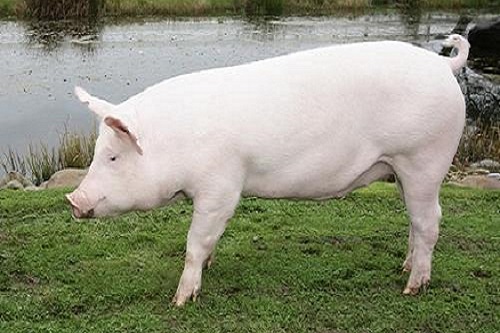
Middle White Yorkshire
- Breed was evolved in northern England by crossing the large white with smaller breed .
- This breed is white in colour with long back.
- It has relatively more fat production compared to other breeds.
- This breed is hardy, grows rapidly and has been extensively used in India for improving the indigenous stock in rural areas.
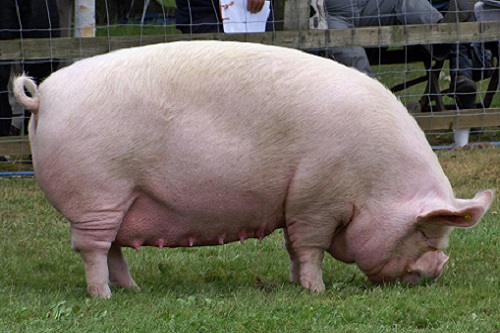
Berkshire
- Berkshire is one of the oldest improved English breeds of pig and is extensively raised.
- It is a typical pork breed with characteristic short and upturned nose.
- It is a medium sized animal, black in color with six white points, on the feet, nose and tail
- The breed is now highly valued as producers of good quality pork.
- In India, especially in the South this breed is popular for upgrading programmes.
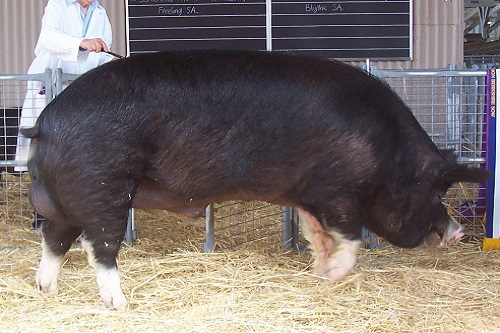
Tamworth
- This breed is developed from central England and derives its name from the town of Tamworth
- Head is long and narrow with long snout and erect ears
- It is docile pig with golden red color, varies from light to dark.
- They are good for bacon production.
- The sows are prolific and the pigs are excellent foragers, which make them suitable for low input production system.
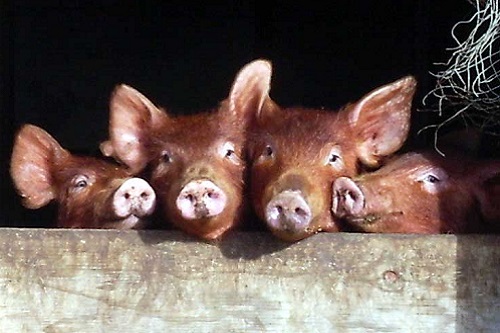
Landrace
- It is a native breeds of Denmark.
- breed is white in colour and characterized by long, deep side, square ham, relatively short legs and heavy top ears.
- Highest quality bacon in the world.
- White colour breed with some black skin spot known as freckles. Mature boar weighs 270 – 360 kg and the sow 200 – 320 kg.
Duroc
- Originated in the Eastern region of the United States.
- The breed is moderately red colored with shades varying from golden to cherry red in color.
- It is a large breed with excellent feeding capacity and prolificacy.
- They are noted for lean meat production.
- They are hardy and capable of growing at a faster rate.
Hampshire
- This breed was originally developed in the USA.
- This type is characterized by its black color with a white belt around the fore quarter of the body
- The body is elongated, well-muscled, clean cut, firm and solid with erect ears.
- They are medium sized, prolific, good nursing mothers and efficient converters of feed.
- Hampshire sows, under well managed conditions, produce up to 2 litters per year with an average litter size of 8 at weaning.
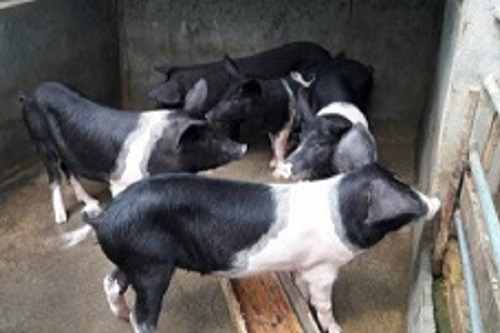
Chester White
- This breed is originated from Chester and Dela countries of USA
- As the name indicates the breed is white in color
- Sow are excellent mother and prolific. The pigs are good feeders, mature early and make good gains.
Indigenous Breed of Swine
Agonda Goan
- Synonym: Traditionally known as “Gavthi Dukor” i.e. village pig
- Breeding Tract: Goa
- Main Use: maintained for pork and sausage making.
- Manure is used for kitchen gardening
- Colour: Mostly Black. Few animals have white patches on legs and face.
- Preferred by local population due to less maintenance cost, better
- adaptability and consumer’s preference, sustain in scavenging situation.
- Peculiarity: Average age at slaughter is about 6-8 months in males with a live weight of about 67kg.

Doom
- Breeding Tract: Assam.
- Name derived from a community locally known as ‘Doom’ rearing these pigs for generations
- Main Use: Meat of Doom pig is lean and considered palatable by the consumer, and hence fetches more price in the market
- Colour: Black
- Pigs have short concave snout. large; flat belly type with short erect ears. Top line is straight with long bristles .
- Management Adapted to a special management system i.e. migratory scavenging system with minimum inputs
- Dressing percentage: 62
Ghoongroo
- Breeding Tract: Darjeeling (West Bengal).
- Main Use: Pork and Manure.
- Morphology: typical bull dog face appearance.
- Colour: Black, Occasionally hooves are white
- Characteristics: Thick coarse and long hair coat, long tail, upwardly curved snout, broad and flattened face with large and heart shaped ears resembling those of elephant.
- Management System: Semi-Intensive , Pig keepers manage the animals both under stall feeding and stall feeding-cum-grazing.
Ghurrah
- Synonym: Deshi, Bareilly Local
- Breeding Tract: Bareilly (Uttar Pradesh)
- Main Use: Pork (Mostly), manure and sometimes for bristles.
- Colour :- greyish black or brownish
- Visible Characteristics: angular body and long straight snout. Legs below hock joint are white. Head is elongated with triangular face and short leaf shaped vertically erected ears.
- Management System: Scavenger
- Peculiarity of the breed: Farmers prefer Ghurrah pigs due to many reasons like fewer occurrences of diseases, hardiness and adaptability to local conditions.
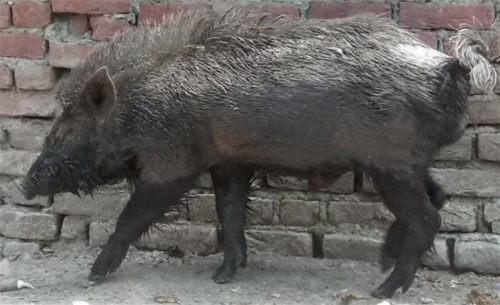
Niang Megha
- Synonym: Meghalya Local, Khasi Local.
- Breeding Tract: Meghalaya
- Main Use: Pork, Bristle & Manure
- Adaptability: Adapted to hilly terrain of Meghalaya state
- Colour: Black, star shaped white patches at forehead and sometimes hock joint
- Management System: Semi-Intensive
- Peculiarity of the breed: typical wild look, erect bristle in dorsal mid-line, small erect ear extended vertically.
Nicobari
- Synonym: Ha-un/Naut
- Breeding Tract: Andaman & Nicobar
- Main Use: pork Nicobari pig rearing is considered as a symbol of pride and asset in a family and pigs are linked with all socio-cultural activity/ ceremony of Nicobari tribes
- Colour: Mostly Black and brown. Few are creamy-white, reddish-brown and black and brown mixed
- Visible Characteristics: Medium to short snout and short erect ears, No curling is the characteristic feature of the tail.
- Management System: Extensive, Free Ranging.
- Dressing percentage: 75
- Peculiarity of the breed: Nicobari pigs are ferocious in nature.
Tenyi Vo
- Synonym:; Naga Local, Suho
- Breeding Tract: Kohima, Nagaland
- Main Use :- Pork, Bristle and Manur.
- Colour: Mostly black in both sexes.
- Visible Characteristics: pendulous belly touching the ground in females, straight tail ending with white switch ,white markings on the forehead.
- Management System: Extensive, Scavenging.
- Dressing percentage: 67
Zovawk
- Synonym: Mizo local
- Breeding Tract: Mizoram , Well adapted in hilly region .
- Main Use: Pork and Manure
- Colour: Black. White spot on the forehead (star), white patches on belly (sometimes) and white boot
- Visible Characteristics: Erect ears, concave snout, pot belly, concave top line and long bristles on mid-line
- Management System: Extensive, Scavenging.
- Dressing percentage: 70
- Peculiarity of the breed: Zovawk are social animals, they never stay alone under normal conditions.
Breeds of Horses
Kathiawari
- The Kathiawari breed horse is accepted throughout the India as the purest and oldest of all horse breeds.
- Breeding tract of the breed: Kathiawar , Gujarat
- Most prominent body colour: chestnut followed by bay , grey and dun. Black is the color not found in Kathiawari horses
- The physical characteristics of Kathiawari horses are concave profile, long neck, short leg and squared quarters
- Best breed of horse.
- Peculiarity of the breed: Long and curly hairs are present on mane and tail .
- Dorsal stripping of brown colour along spine is another characteristic of Kathiawari horses.

Marwari/Malani
- Marwari breed native of Marwar region of the Rajasthan.
- Known for its inward-turning ear tips
- Marwari horses: reared mainly for riding and sports.
- Marwari: descended from native Indian ponies crossed with Arabian horses
- Peculiarity of the breed: It has strong limbs with clearly defined tendons, square frame and a thin coat, It has a well developed sense of smell and hearing which is very useful in desert.
- Most famous Marwari horse of Maharana Pratap’s is Chetak.
- Predominant body colour: Brown
- Marwari Horse Society: The only government-authorized registration society for Marwari horses.
Spiti/Chhumurthi
- Spiti horses – distributed in Spiti valley and adjoining areas of Kullu (Himachal Pradesh).
- These horses are smaller in height.
- Spiti ponies have two strains, Spiti pure and Konimare The Konimare ponies are comparatively taller.
- They are capable of thriving in cold regions under adverse conditions of scarcity of food, low temperature and long journeys at high altitude.
- The Spiti horses are hardy and surefooted.
- Legs are thick and covered with long coarse hairs, the mane is longer.
Zanskari
- Zanskari horses are available in Leh and Laddakh area of Jammu and Kashmir.
- Predominant body colour is grey followed by black and copper
- Known for their ability to work, run adequately and carry loads at high altitude
- Horses are medium in size, well built and 120 to 140 cm high.
- Peculiarity: The breed is on the verge of extinction as only few hundred horses are present, A Zanskari horse breeding farm has been established at Leh by Dept. of Animal Husbandry, Jammu & Kashmir.
- Main Use: Work- draught, transport and riding; Socio-cultural- game (polo)
- The horses are known for their hardiness and ability to work at high altitude
- Colour: Common body colours are grey, black and copper.
- Visible Characteristics: The animals are alert, well built, medium in size, have wide face, uniform gait and predominant eyes. Tail is long and heavy almost touching the ground. Body hairs are fine, glossy and long.
Manipuri
- They are found in Manipur and Assam.
- One of the purest and prestigious breed of equines of India
- A strong and hardy breed and has very good adaptability to extreme geo-climatic conditions
- It is one of the well-known breeds of India and has been claimed as the oldest polo pony
- They are found in Manipur and Assam.
- Colour: Common body colours are bay, dark bay, brown, reddish brown, grey, chestnut and roan
- Visible Characteristics: Ears are alert and almond shaped. Head is light and well proportioned with a straight profile. Neck well formed with a full mane. Legs well built and sturdy, and foot has tough hoof.
- Peculiarity of the breed: famous for polo and riding purposes.
- Pony played significant role in the field of war
- It is a matter of concern that the number of Manipuri has decreased drastically.
Bhutia
- Bhutia are distributed in Nepal, bhutan, Sikkim and Darjeeling
- They are usually grey or bay coloured and similar to the Tibetan pony.
- Predominant colour: grey
- Used as pack animal, transportation & Light agriculture work
- Due to a lack of any regimented breeding programs & poor nutrition, these animals tend to be smaller & less robust than other breeds.


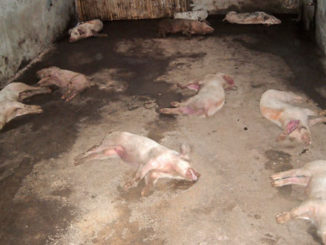
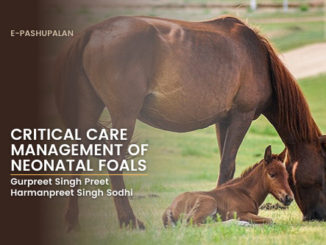
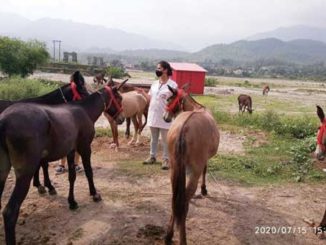

Be the first to comment